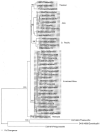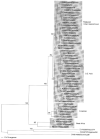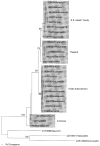Microevolution and virulence of dengue viruses
- PMID: 14696333
- PMCID: PMC3045824
- DOI: 10.1016/s0065-3527(03)59009-1
Microevolution and virulence of dengue viruses
Abstract
The evolution of dengue viruses has had a major impact on their virulence for humans and on the epidemiology of dengue disease around the world. Although antigenic and genetic differences in virus strains had become evident, it is mainly due to the lack of animal models of disease that has made it difficult to detect differences in virulence of dengue viruses. However, phylogenetic studies of many different dengue virus samples have led to the association between specific genotypes (within serotypes) and the presentation of more or less severe disease. Currently, dengue viruses can be classified as being of epidemiologically low, medium, or high impact; i.e., some viruses may remain in sylvatic cycles of little or low transmissibility to humans, others produce dengue fever (DF) only, and some genotypes have been associated with the potential to cause the more severe dengue hemorrhagic fever (DHF) and dengue shock syndrome (DSS) in addition to DF. Although the factors that contribute to dengue virus epidemiology are complex, studies have suggested that specific viral structures may contribute to increased replication in human target cells and to increased transmission by the mosquito vector; however, the immune status and possibly the genetic background of the host are also determinants of virulence or disease presentation. As to the question of whether dengue viruses are evolving toward virulence as they continue to spread throughout the world, phylogenetic and epidemiological analyses suggest that the more virulent genotypes are now displacing those that have lower epidemiological impact; there is no evidence for the transmission of antigenically aberrant, new strains.
Figures




References
-
- Aiyar A. The use of CLUSTAL W and CLUSTAL X for multiple sequence alignment. Methods Mol. Biol. 2000;132:221–241. - PubMed
-
- An J, Kimura-Kuroda J, Hirabayashi Y, Yasui K. Development of a novel mouse model for dengue virus infection. Virology. 1999;263:70–77. - PubMed
-
- Balmaseda A, Sandoval E, Perez L, Gutierrez CM, Harris E. Application of molecular typing techniques in the 1998 dengue epidemic in Nicaragua. Am. J. Trop. Med Hyg. 1999;61:893–897. - PubMed
-
- Barnes WSJ, Rosen L. Fatal hemorrhagic disease and shock associated with primary dengue infection on a Pacific island. Am. J. Trop. Med Hyg. 1974;23:495–506. - PubMed
Publication types
MeSH terms
Grants and funding
LinkOut - more resources
Full Text Sources
Other Literature Sources
Medical
Research Materials
Miscellaneous
